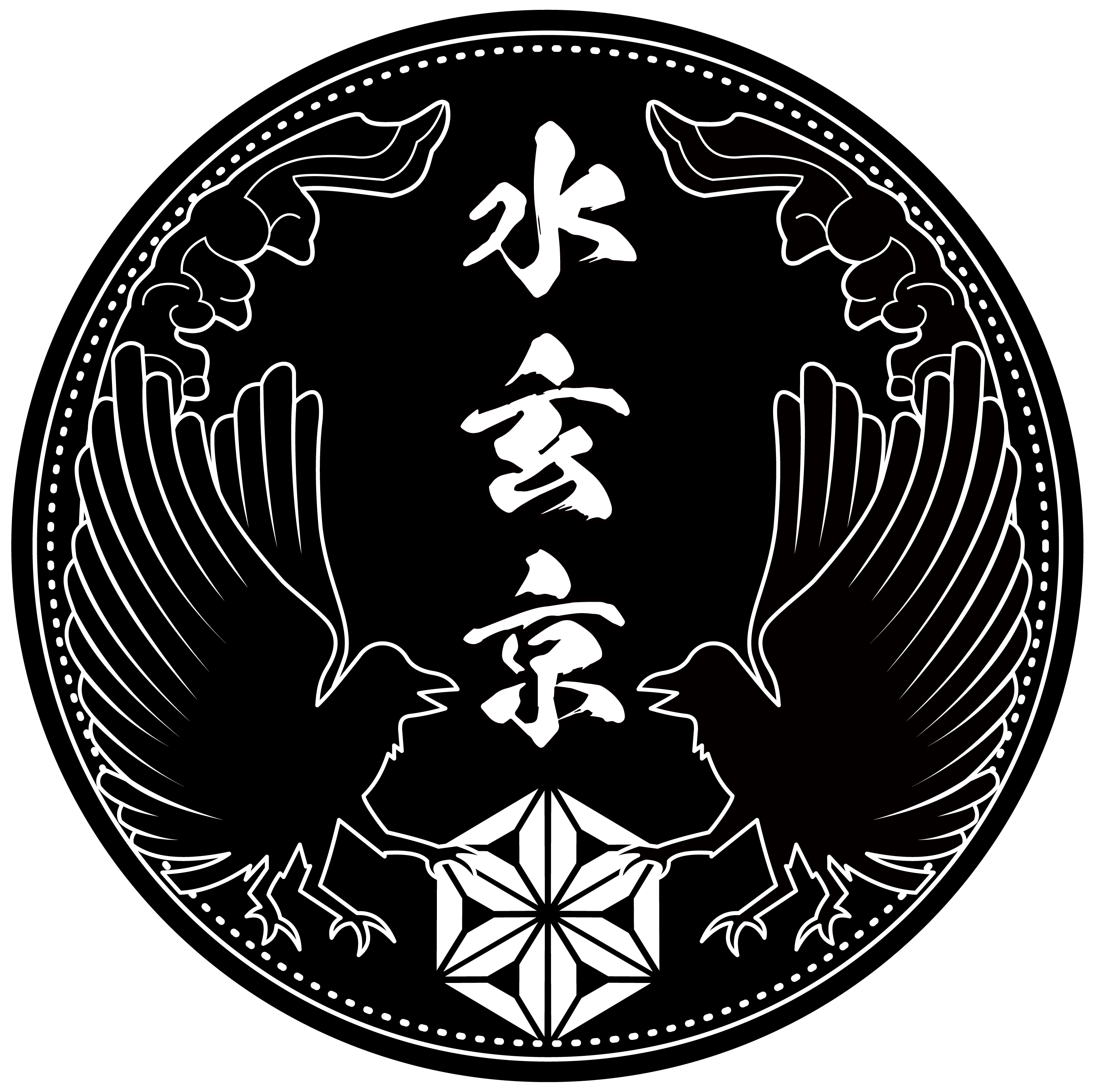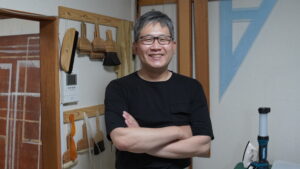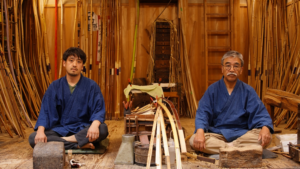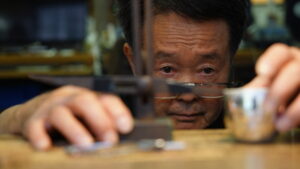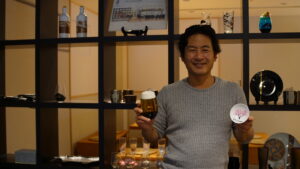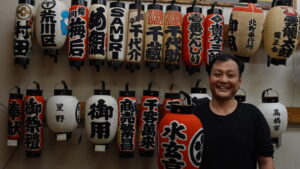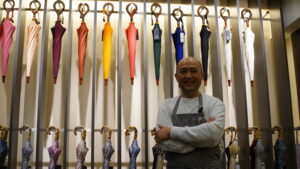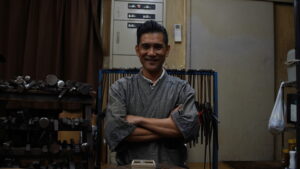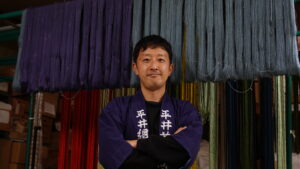Mr. Shunji Mori, the representative of Mori Shunzan, is still working as a craftsman of Kyo-pottery. He was influenced by the craftsman Kenzan Ogata, a ceramic artist in the Edo period. Mr. Mori looks typical Japanese craftsman, but he keeps a great relationship with his co-worker like a family and they all call him by his first name, “Mr. Shunji!” In this interview, we asked him about his background and his beliefs as a ceramic artist.

- —Why did you decide to become a potter?
-
When I was in high school, my older brother went to college in Tokyo and got a job. Then, my father suggested me that becoming a potter would be easy option because I would be free and wouldn’t have to study. At the time, I thought I would be working at the ward office or city hall, but after attending a ceramics school for two years, I decided to become a potter since I thought it would be an interesting and rewarding job.
- —So did you join the family business and start your current work after that?
-
No, I joined the family business at one time, but at the time I thought the family business was boring as they made only similar products. I wanted to make one big piece of art anyway! From this, I apprenticed myself to a different craftsman who was not my father. I studied for about eight years there and was able to relearn the art of pottery from scratch. Later, at the age of 28, I decided to get married and returned to the family business to help. Even so, I never lost my desire to be an artist, and I strongly wanted to make large one-of-a-kind pieces as I felt like it before. When my father became ill at the age of 40, he asked me to take over the family business as my main occupation, and I accepted the offer. I have been into ceramics since I was in my 20s, and I realized how interesting it is as well as understanding the depth of ceramics every time I worked on it. Even now, I am still pursuing the possibility of making better ceramics.

- —I guess you have created your current style after many twists and turns. What are the characteristics of your work?
-
I create works influenced by Ogata Kenzan. He specializes in openwork carving, painting of autumn leaves, cherry blossoms, etc., and creates many pieces that you can feel seasons. Also, although it may be a little different from the characteristics of my art, I am always trying to continue to produce many pieces with great quality. Even after I think I have completed a piece, I check them carefully and if I find something that needs to be corrected, I try to make it better by putting some extra effort.

- —Are there any people who have influenced you?
-
The person who influenced me was my mentor, Yoshihisa Miyashita. He gave me a lot of guidance both mentally and technically.
- —Are there any memorable words from your mentor?
-
He always told me, “You will study ceramics until you die.” He was 75 years old at the time. He said it is okay to make many mistakes but trying to improve them is important. It is sometimes painful to know that there is no end in terms of creating ceramics, but it is very interesting to pursue one thing!

- —Are there any words that are important to you?
-
It is difficult to give you words that I find important, but I do have an important thought.
That is, even if I don’t get rewarded, I hope that the next generation will. In fact, my father took care of many people, and I sometimes feel blessed that his actions have been rewarded back to me. For that reason, I hope that I can accumulate virtue and not seek reward for myself but bring the luck to the next generations. - —That’s a lovely thought. So, what do you keep in mind when you are making ceramics?
-
Anyway, we need to “take good care of the clay”. In Japan, clay is becoming harder and harder to obtain. In particular, Kyoto is a production area where clay is hard to get. I believe that by taking care of the materials carefully, our products will reflect our feelings. Also, in terms of business operations, I am aware of the importance of “taking on a job you don’t like right away,” and I want my employees to be aware of this as well. If you think you don’t want to do a certain task, everyone probably thinks they don’t want to do it either. From this, by taking the initiative at such a situation, I think we can reduce the burden on those around us. Therefore, I am very conscious of the fact that I do not turn my back on things I don’t like, but rather go ahead and work on them.

- —Is there anything, not only in ceramics, that young artisans today should be particularly aware of?
-
I guess it is imitating or copying something good from the past. I believe that imitating will always improve your skills or technique. When it comes to ceramics, in pottery, no two pieces are exactly alike, so if you find a potter you like, I think it is a good idea to try to imitate them. In the process, I think you will understand and establish your own style.
- —Have you ever collaborated with other artisans?
-
I have collaborated with a traditional craftsmen. We tried using lacquer and bamboo, and we went through a lot of trial and error. But it is difficult because we have to agree with each other and find a compromise. Also, although it is not a collaboration, the Ceramic Society decides what to produce every year among craftspeople and we are working on it. By the way, 2022 is a wind chime. Come to check it again! After all, I think it is best to make what you like and adjust to the demand of the market.
- —Finally, what is your vision for the future?
-
I would like to expand my products overseas. Recently, I’ve had several requests to produce flowerpots, and that made me start growing bonsai myself! When I bought the seeds and grew the plants myself, I started to think from a consumer’s perspective, such as “how can I make bonsai look cool? That was very interesting, and I have been making pots while growing different kinds of plant plants. Now, I am interested in a succulent plant called pachypodium, which is an African plant, and I am learning a lot about it. Plant pots can be sold overseas, so I would like to put more effort into them in the future.

You can watch the Kiyomizu Pottery production process on YouTube!
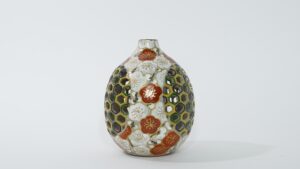
Suigenkyo Online Store
We offer a wide range of products including tableware, accessories, and interior design.
Suigenkyo YouTube
You can see the making process of the products listed on Suigenkyo Online Store.
